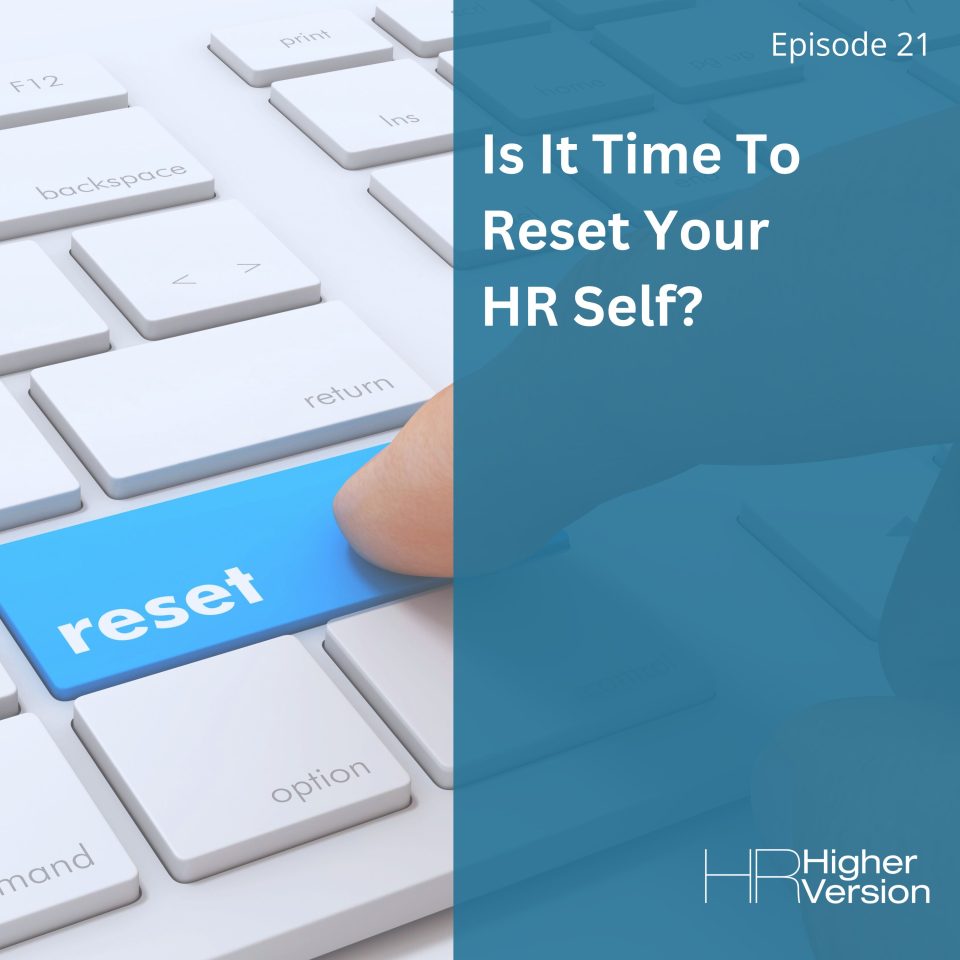Whether you’re already leading a team or on the path to becoming an HR executive, you know that the road to success can sometimes feel like a series of hurdles—challenges you’re expected to solve on a daily basis, decisions that require your expertise, and the constant balancing act of leading others while also managing your own career growth.
But here’s the thing: When you’re so focused on pushing forward, there’s a tendency to forget one critical component of growth. That’s the need to occasionally hit pause and reset.
Has your computer ever started glitching or running slowly? I know it has. And when you call IT support what is the first thing they ask you? Say it with me – did you turn it off and turn it back on again???
Seems simple, right? Yet, this simple action can often solve a number of problems and help the system get back on track. Well, the same principle applies to your career.
Lately, I’ve been thinking about the importance of resetting—not in a technical sense, but in your professional life.
As an HR professional, you are often in the driver’s seat, navigating complex organizational challenges, handling employee relations, and shaping company culture.
But even the most skilled professional needs to step back and recalibrate every once in a while.
It’s the equivalent of turning your computer off and back on again. Sometimes things freeze, and you can’t figure out why. The first piece of advice an IT professional will give you: turn it off and turn it back on again.
This reset—this pause—allows the system to reboot and recalibrate, clearing out any errors or glitches.
Now, imagine applying this concept to your career. If you’re feeling stuck, overwhelmed, or unsure of the next step, sometimes the best thing you can do is pause and reset your mindset, priorities, or strategy. Just as technology needs a break to run more efficiently, so do you.
Why Taking a Step Back is Crucial for Forward Movement
In human resources, we are constantly balancing short-term tasks with long-term goals. We’re focused on filling positions, addressing employee concerns, and managing team dynamics.
However, if you don’t take time to step back and evaluate where you are, you may find yourself spinning in circles, unable to see the bigger picture.
When you reset—whether it’s mentally, physically, or strategically—it gives you the chance to gain clarity. You give yourself permission to pause the constant flow of work and allow space for reflection.
This pause helps you assess where you’ve been and where you want to go, ultimately providing the tools and insights necessary to move forward with intention.
Think about it this way: you wouldn’t just throw your computer away after it experienced a glitch, right? Although I admit, I’ve been tempted!
You’d simply give it the reset it needs to get back to running optimally. The same principle applies to your HR career. Sometimes, stepping back is the key to moving forward.
How Resetting Helps You Build a Stronger HR Leadership Foundation
So, what does this actually look like?
Resetting isn’t just about taking a break—it’s about taking intentional action to reset your mindset, redefine your goals, and reframe your leadership approach.
Based on your personality, your reset may look different from someone else’s.
For me, I want to curl up and get lost in a good fiction book. For my husband, it’s hopping on the tractor and pushing out trees or discing a field or whatever he’s doing out back on our property.
Whatever that reset looks like for you, it gives you the opportunity to clear away the clutter so you can see your path forward with fresh eyes.
Whether it’s stepping back from a challenging project to recalibrate or seeking feedback from a mentor, these pauses are critical for growth and advancement.
Building HR Momentum After Your Reset
Once you’ve taken the necessary step back, the next challenge is to move forward with purpose and confidence.
After resetting your internal system, it’s time to hit the ground running. Now that you’ve reevaluated your goals and sharpened your leadership strategy, you can approach challenges with a renewed focus.
For example, if you’ve been struggling with work-life balance, a reset might involve reassessing your boundaries, learning to delegate more effectively, or seeking new leadership skills to manage both your time and your team better.
After a reset, you’re more equipped to make strategic decisions and drive meaningful change within your organization.
Put Your HR Reset Into Practice
This week I’m going to challenge you to take one small step to reset. Maybe it’s as simple as taking a 15-minute break in your day to step outside and breathe, or perhaps it’s scheduling a time to review your career goals and progress.
Whatever it is, create space to reset and give yourself permission to pause.
Take note of how you feel after that reset and what new insights you gain. Notice how much more clarity and energy you have as you move forward with your next steps.
And remember, the reset isn’t going to be a one-time fix. Unfortunately, your computer is going to glitch again at some point.
So make sure to make your reset an ongoing practice that can help you stay aligned with your goals and accelerate your progress toward the executive level.


